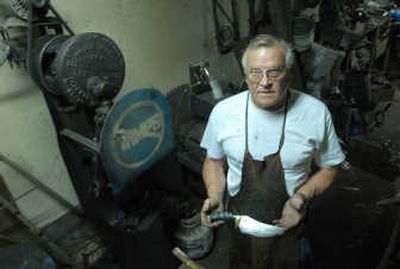Creative Outlet

ATHOL – Relentless as the hammer on his anvil, Ray Rantanen chased down an elusive hobby through noisy, smoke-smudged days until he forged himself into a master craftsman. Now, after 30 years of trial and error, Rantanen produces Damascus blades in his one-man Athol shop that are both beautiful works of art and nearly unbreakable tools.
Damascus blades take their name from the city in Syria where blacksmiths of the 12th century used a unique steel forging process that created a streaked pattern in the final product. The original process was lost in the 14th century, and modern smiths re-created the appearance by layering steels and folding them repeatedly. The folds of steel then show up as whorls, loops and waves on the finished surface.
“There’s no two alike. It’s got its own fingerprint,” Rantanen said.
Rantanen grew up in the Kellogg area. The son of a railroad engineer, he spent his youth fishing in the many creeks and lakes. He made his way through college and finished with a doctorate in physics from Washington State University in 1971, specializing in how steels change in high temperatures. That research led him to work in the aerospace industry with Martin Marietta in Colorado and contract work with NASA investigating the effects of the orbital environment on metals. He eventually moved pack to North Idaho in 1992 to be near family.
His background gave him key insight that would inform the hobby he picked up in 1974 as a creative outlet.
“I always liked to draw, (but) it was hard to find the right time and space to draw,” Rantanen said. “I thought I should pick a hobby that not many people do, that you can escape in.”
He remembered an old anvil that his father had owned and made arrangements to pick it up and set up a small shop. After that, he said he read every book he could find on the topic of blacksmithing and then put hammer to anvil.
“It was just practice, practice, practice and throw away stuff for months,” Rantanen said. “I must’ve thrown away a ton of steel learning.”
Rantanen said he’s never seen another blacksmith make a knife and has never been to a knife show. And while his grounding in physics helped him understand how steel reacted inside the forge, it didn’t helm him shape the steel with his hammer.
“You can learn what you want, but there’s no substitute for experience,” he said.
Plain-spoken and direct, Rantanen is happy to share everything he’s learned after decades at the anvil and more than a quarter-century specializing in knives. For instance, hanging in his cluttered shop is the recipe for his Damascus blades, which he’s happy to point out and explain.
Each knife begins as seven layers of steel. The core is a type of steel called O-1, which provides hardness and strength. Flanking the O-1 core are two S-2 steel layers that Rantanen recycles from spent jackhammer bits. Sandwiching each of these layers are thin shims of a softer mild steel.
After being cut to size, this seven-layer billet is folded over on itself and forge-welded – hammered while red-hot until it fuses – again and again until there are 224 layers. The mild steel helps separate the different layers and retain their individual properties. Under intense heat, carbon atoms tend to migrate through the steel like bubbles in boiling water. The silicon in the S-2 blocks the path of this migrating, keeping the blade from becoming homogenized. The result is a steel that has both great hardness for excellent cutting and flexibility to avoid breakage.
“It’s really hard to do right,” Rantanen said. “Besides being beautiful, it’s also indestructible. It stays sharp (and) is easy to sharpen.”
After he finishes with the blade, Rantanen marries the steel to a wide variety of handles. In his shop are stacks of boxes that hold exotic hardwoods, antlers and ivory. One of the strangest materials he uses is oosik, the penile bone that comes from walruses, seals, sea lions and polar bears. In addition, he hand-makes a leather sheath for each of his knives.
The blades sell to collectors for their display value – he’s sold several to the crown prince of Saudi Arabia – but also to hunters and survivalists who appreciate their utility and endurance.
Rantanen produces 200 to 250 knives a year and estimates that he’s made more than 4,000 in his life. He said that 30 percent of his business is repeat customers.
“It’s been two years since I’ve done any aerospace work,” Rantanen said. “I was having more fun making knives.”
Beyond the Damascus knives, Rantanen forges knives out of saw blades used in the logging industry, spring steel, railroad spikes and horseshoes. He has created wood-carving tools for Native American tribes, a job that led him to try his hand at carving totem poles (which he creates to customer order). He makes a throwing tomahawk out of horse hoof rasps. And he creates the occasional sword or exotic fantasy weapon on request. One of these was the 17-inch giant bowie knife labeled “Bear Killer” for a man working in Alaska who couldn’t carry a gun in the national parks.
“I have fun,” Rantanen said. “I take a break and make primitive weapons, dance rattles.”
What started as a hobby in which he could lose himself after work became a full-time occupation, pushing aside first his full-time career and then his part-time consulting business. Now, Rantanen said he’s content to walk the 50 feet from his log home to his shop, where he pursues the ineffable goal of blacksmithing perfection.
“I try to improve every year,” he said. “Now the improvements are subtle.”